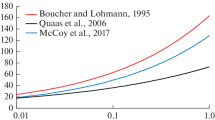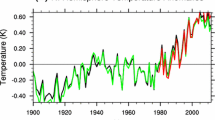Abstract
ANTHROPOGENIC sulphate aerosols are believed to affect the radiation budget of the Earth in two ways. Through the direct effect they scatter solar radiation back to space, producing a radiative forcing whose global annual mean has been estimated to lie in the range −0.3 to −0.9 W m−2 (refs 1–3). This is significant compared to the longwave forcing due to increases in anthropogenic trace gases since the beginning of the industrial era, estimated at +2 to +2.5 W m−2 (ref. 4). Aerosols also have an indirect effect, altering the distribution and concentration of cloud condensation nuclei (CCN) and hence the number density and size distribution of cloud droplets, thus affecting the solar radiative characteristics of clouds5,6. This is harder to quantify than the direct effect, because it depends on complex and poorly understood interactions between aerosols, CCN and cloud properties. Here we use sulphate aerosol data derived from a three-dimensional chemical transport model7 to estimate the indirect radiative forcing by low-level water clouds using a general circulation model. We estimate that the indirect aerosol effect at the top of the atmosphere is approximately −1.3 W m−2 in the global annual mean. Although this value is subject to a high level of uncertainty, even if the effect is only half as large it would still exceed many estimates of the direct effect, demonstrating its potential importance in climate change.
Similar content being viewed by others
References
Charlson, R. J., Langner, J., Rodhe, H., Leovy, C. B. & Warren, S. G. Tellus 43, 152–163 (1991).
Kiehl, J. T. & Briegleb, B. P. Science 260, 311–314 (1993).
Taylor, K. E. &. Penner, J. E. Nature 369, 734–737 (1994).
Houghton, J. T., Jenkins, G. J. & Ephraums, J. J. (eds) IPCC Climate Change: The IPCC Scientific Assessment (Cambridge Univ. Press, 1990).
Twomey, S. A. Atmos. Envir. 8, 1251–1256 (1974).
Twomey, S. A., Piepgrass, M. & Wolfe, T. L. Tellus 36B, 356–366 (1984).
Langner, J. & Rodne, H. J. atmos. Chem. 13, 225–263 (1991).
Cullen, M. J. P. Met. Mag. 122, 81–94 (1993).
Smith, R. N. B. Q. JI. R. met. Soc. 116, 435–460 (1990).
Martin, G. M. & Johnson, D. W. in Proc. 11th int. Conf. Clouds and Precipitation, Montreal 158–161 (AES, Downsview, 1992).
Bower, K. N. & Choularton, T. W. Atmos. Res. 27, 305–339 (1992).
Martin, G. M., Johnson, D. W. & Spice, A. J. atmos. Sci. 51, 1823–1842 (1994).
Slingo, A. J. atmos. Sci. 46, 1419–1427 (1989).
d'Almeida, G. A., Koepke, P. & Shettle, E. P. Atmospheric Aerosols: Global Climatology and Radiative Characteristics (Deepak, Hampton, Virginia, 1991).
Leaitch, W. R., Isaac, G. A., Strapp, J. W., Banic, C. M. & Wiebe, H. A. J. geophys. Res. 97, 2463–2474 (1992).
Nicholls, S. Q. JI. R. Met. Soc. 110, 783–820 (1984).
Nakajima, T. & King, M. D. J. atmos. Sci. 47, 1878–1893 (1990).
Han, Q., Rossow, W. B. & Lacis, A. A. J. Clim. 7, 465–497 (1994).
Taylor, J. P. & McHaffie, A. J. atmos. Sci. 51, 1298–1306 (1994).
Charlson, R. J. et al. Science 255, 423–430 (1992).
Kaufman, Y. J. & Chou, M.-D. J. Clim. 6, 1241–1252 (1993).
Boucher, O. & Rodhe, H. Department of Meteorology Report CM-83 (Stockholm Univ. 1994).
Albrecht, B. A. Science 245, 1227–1230 (1989).
Novakov, T. & Penner, J. E. Nature 365, 823–826 (1993).
Hegg, D. A., Ferek, R. J. & Hobbs, P. V. J. geophys. Res. 98, 14887–14894 (1993).
Platnick, S. & Twomey, S. A. J. of appl. Meteor. 33, 334–347 (1994).
Wigley, T. M. L. Nature 349, 503–506 (1991).
Author information
Authors and Affiliations
Rights and permissions
About this article
Cite this article
Jones, A., Roberts, D. & Slingo, A. A climate model study of indirect radiative forcing by anthropogenic sulphate aerosols. Nature 370, 450–453 (1994). https://doi.org/10.1038/370450a0
Received:
Accepted:
Issue Date:
DOI: https://doi.org/10.1038/370450a0
- Springer Nature Limited





